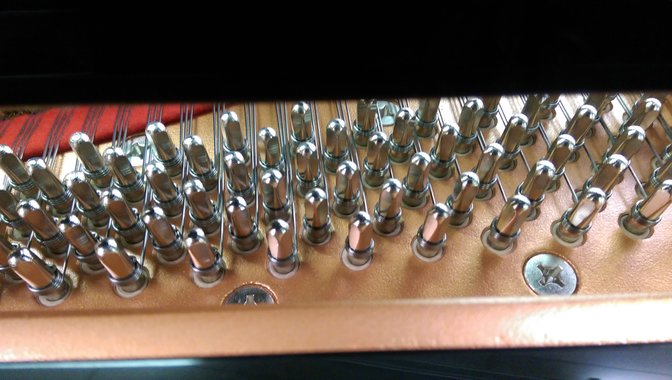I don't think that there's any tool in music that is more universal than the circle of fifths. Before you correct me on the name of this tool, I'm aware that it's also referred to as the circle of fourths and the circle of keys. This can be confusing because when they're referred to with different names. They sound like separate entities. That makes them seem more complicated and mysterious than they really are. But I'm going to give you a full explanation of the circle of fifths and how to use in music.
Why a Circle?
First of all, what is the circle of fifths and why is it even referred to as a circle? Let me start out by saying that the circle of fifths by definition is referred to as a geometrical representation of the 12 different pitches in music as they are referred to by the first 7 letters of the alphabet. The reasons that it's referred to as a circle is because it is cyclical and therefore circular. Sit down at a keyboard and press any note as you count from one to twelve. After twelve, you'll arrive at the same note you started on.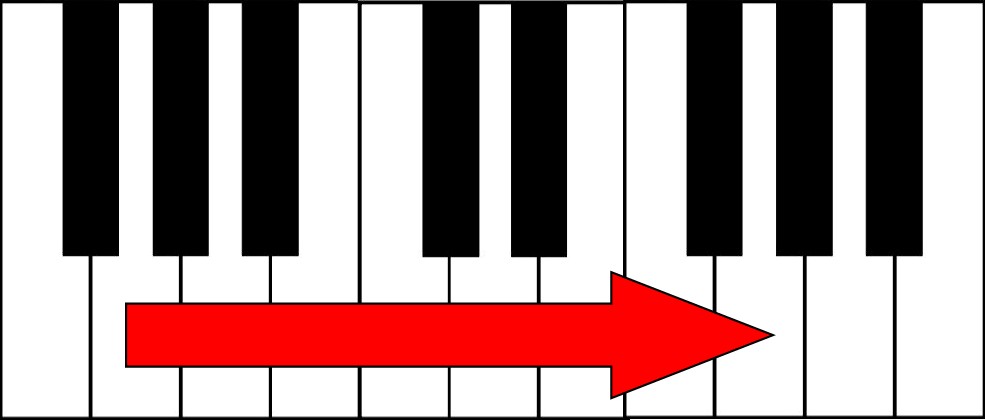
As you look at the circle of fifths, you'll notice that the letters are not in alphabetical order. They actually follow a pattern that is based on major keys of music. A key of music is a menu of seven different notes in which you draw from to play a song or piece of music. Major keys of music are differentiated by the lettered sequence of notes and the number of sharps or flats that exist within them. That's also how they are sequenced within the circle.
Layout and Pattern
This circle of fifths pattern is based on the first five notes of a key of music. You can see that the layout of the circle is 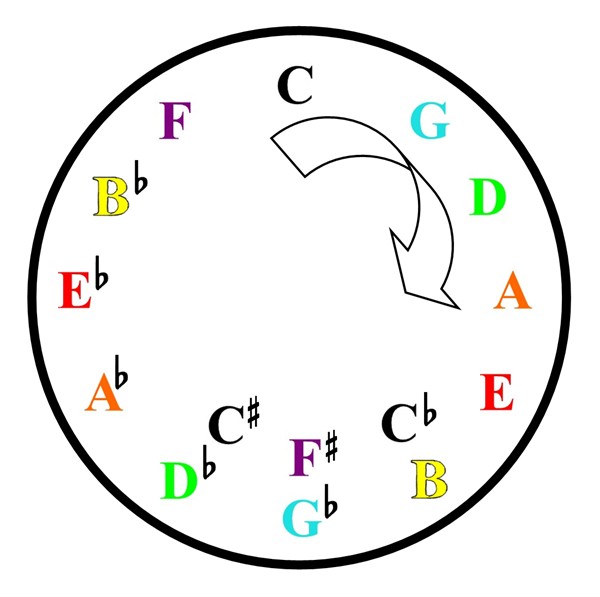 very much identical to a clock with the exception of letters instead of numbers. You have C at the very top and as you move clockwise, G is next in the sequence, D follows, etc. Each Letter is separated by an interval of a fifth. If you break a fifth interval down in it'most basic terms, they're actually notes that are 7 half steps apart. An easier way to identify fifths is to be familiar with all 12 Major chords. Look at any two of these notes and they spell out a Major chord without the third in between them. Just think of power chords which consist of only the root and the fifth.
very much identical to a clock with the exception of letters instead of numbers. You have C at the very top and as you move clockwise, G is next in the sequence, D follows, etc. Each Letter is separated by an interval of a fifth. If you break a fifth interval down in it'most basic terms, they're actually notes that are 7 half steps apart. An easier way to identify fifths is to be familiar with all 12 Major chords. Look at any two of these notes and they spell out a Major chord without the third in between them. Just think of power chords which consist of only the root and the fifth.
The Circle of Fifths Reveals Major Keys of Music
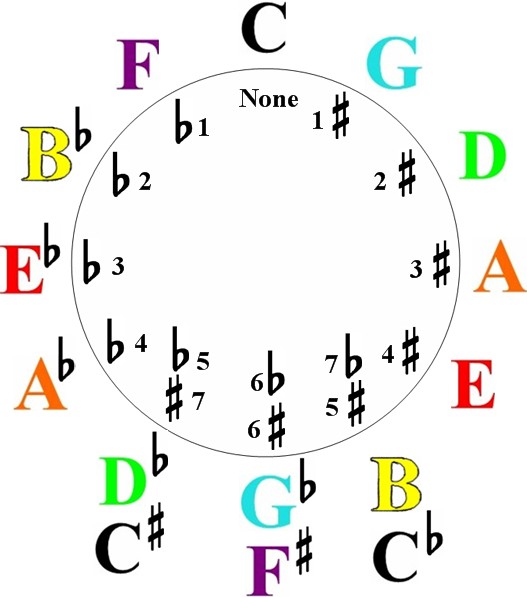 Now that we understand the concept of the circle of fifths, how can we actually use it in music? The most fundamental way it's used is to represent all 12 Major keys of music. At the very top and center is the key of C Major in which there are no sharp or flat notes in the key. It's the basis of all Major keys. If you move to the next key clockwise, you arrive at G Major in which you have one sharp. Proceed around the circle and each key collects a new sharp until 7 sharps are attained.
Now that we understand the concept of the circle of fifths, how can we actually use it in music? The most fundamental way it's used is to represent all 12 Major keys of music. At the very top and center is the key of C Major in which there are no sharp or flat notes in the key. It's the basis of all Major keys. If you move to the next key clockwise, you arrive at G Major in which you have one sharp. Proceed around the circle and each key collects a new sharp until 7 sharps are attained.
But what if you move counter-clockwise? It actually still moves the interval of a fifth but in the opposite direction. You're moving a fifth in the other direction but with the same interval. This also begins the keys that have flats in them. F Major has one flat, B flat Major has two flats, etc.
Just to clarify, if you move clockwise, you're moving through all the keys that have sharps in them. If you move counterclockwise, you're moving through all the keys that have flats in them. Something interesting happens at the bottom the circle. The keys with sharps and flats overlap one another and you have enharmonic keys. In other words, they have two different names but they're the same notes. The only difference is: one has flats and the other has sharps.
Representing Sharps and Flats
The Circle of fifths also represent the order of sharps and flats. You can determine the order of sharps or flats just by 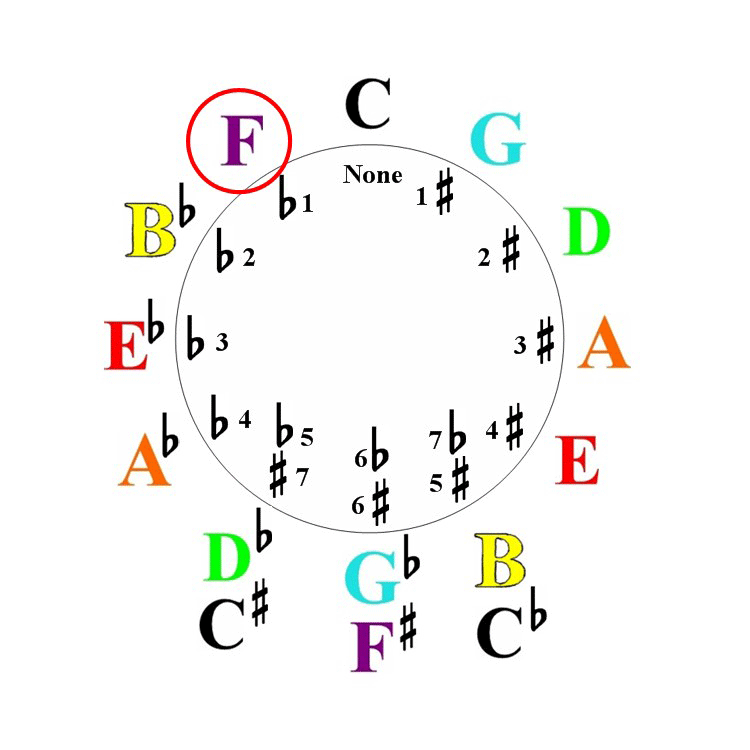 looking at the letters on the circle. Sharps start with an F sharp. From this perspective, we are not looking at F as the key of F but looking at it from the perspective of sharps. So our first sharp is F sharp and to find the rest of the sharps simply move clockwise around the circle and you'll find the rest of the order of sharps. C, G, D, A, E, and B.
looking at the letters on the circle. Sharps start with an F sharp. From this perspective, we are not looking at F as the key of F but looking at it from the perspective of sharps. So our first sharp is F sharp and to find the rest of the sharps simply move clockwise around the circle and you'll find the rest of the order of sharps. C, G, D, A, E, and B.
To find the order of flats, start on the B flat and move counter clockwise to E flat, A flat, D flat, G flat, C flat, and F flat.
Similar Keys
Now we've established how the circle of fifths map out keys and the order of sharps and flats for us, what else can the circle of fifths teach us about Major keys of music? One thing it shows us is the similarity of keys. When you have two keys that are next to each other, they're going to differ by only one sharp or one flat. That means that all of the other notes are going to be same as the ones in the key next to it. The only other difference is that their numbering sequence is different. Understanding the 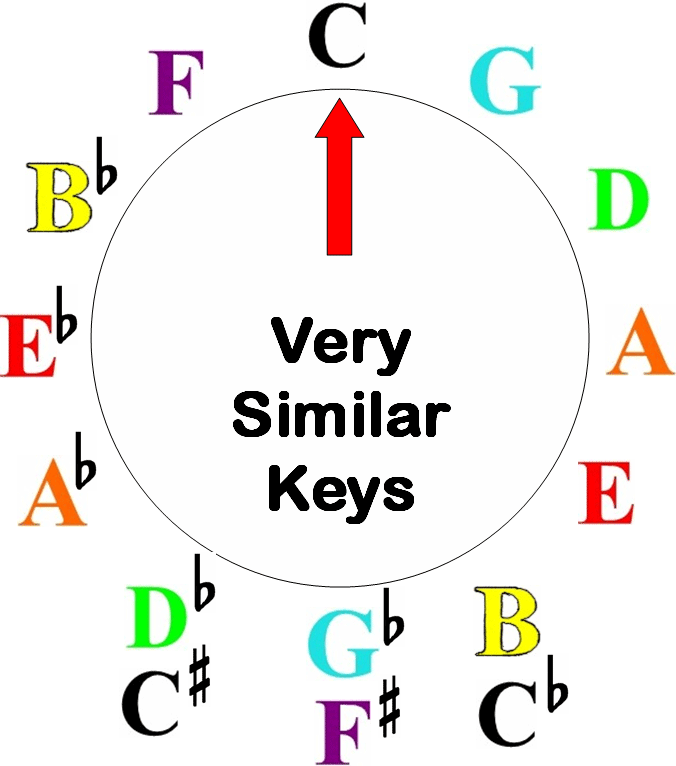 similarity of keys can help you modulate or move from one key to another or write songs with key changes in them so they don't sound abrupt or as if the key change doesn't fit the song you're writing. In order to find a key of music that is most similar to any other, choose the one to the very right or left of it in the circle.
similarity of keys can help you modulate or move from one key to another or write songs with key changes in them so they don't sound abrupt or as if the key change doesn't fit the song you're writing. In order to find a key of music that is most similar to any other, choose the one to the very right or left of it in the circle.
Very Different Keys
The circle of fifths can also teach us what keys sound the most different from one another. Let's say that you were interested in an abrupt key change for a dramatic effect in a song or you needed to modulate to a key to give the verse or chorus of a song a different sound. You may want to find the key that is totally opposite in pitch to the one you're playing in. Locate the key you're in and look 180 degrees in the circle and you will find the most opposite key.
Helping Us Find the Minor keys
Another way the circle of fifths teaches us about keys is it helps us to locate any relative minor key. Every Major key of 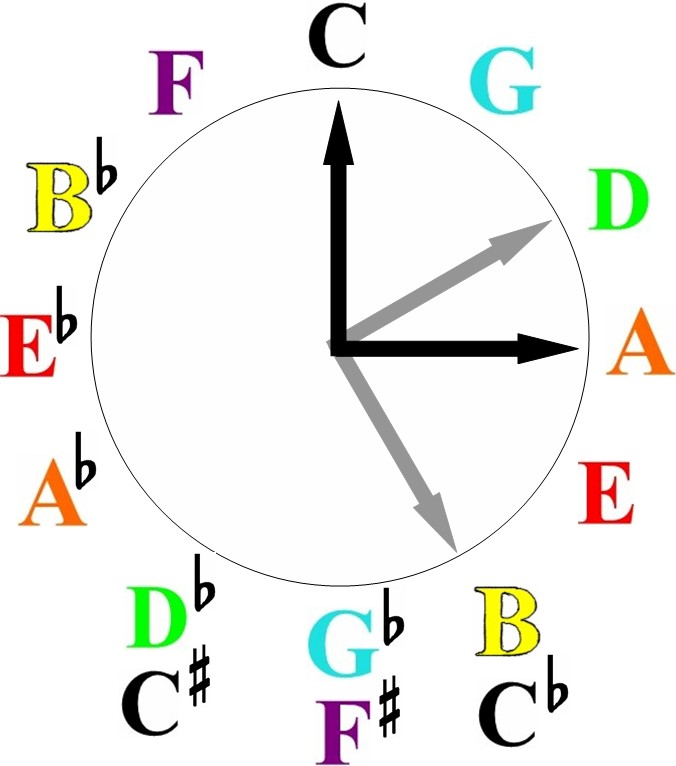 music has a relative minor key and the easiest way to find it in the circle is to move to the center from the Major key and turn 90 degrees to the right. You can find any relative minor key this way.
music has a relative minor key and the easiest way to find it in the circle is to move to the center from the Major key and turn 90 degrees to the right. You can find any relative minor key this way.
Representing Chords
The circle of fifths is also a great tool to represent chords. On the surface each letter in the circle represents a chord by the same name. C represents C Major, G represents G Major, etc. So each one of the 12 Major chords are represented in the circle of fifths.
Primary Chords
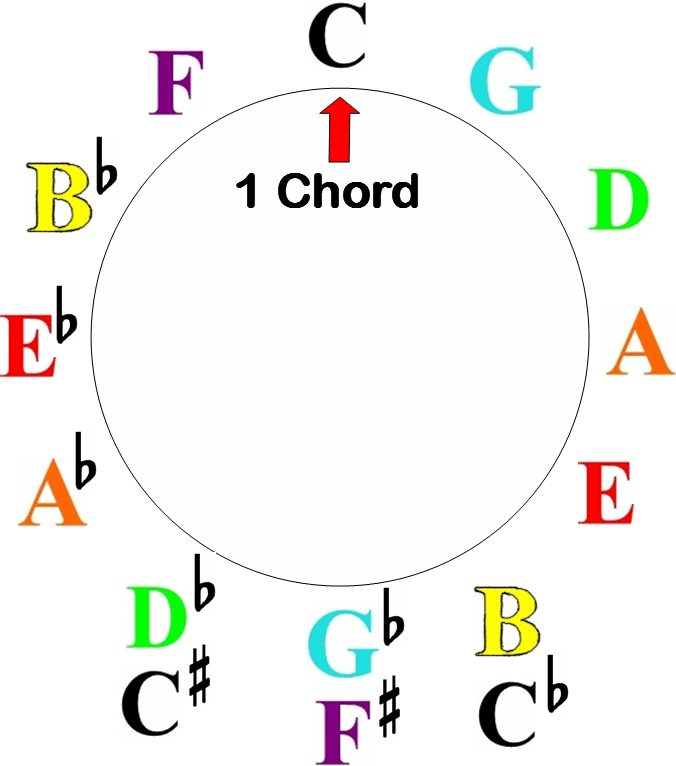 The three most important chords in music can be easily found in the circle. First of all, what are the three most important chords in music? They're the 1, 4 and 5 chords. These are the primary chords in music and are named so because they're the most used chords in music. In order to locate them in any key just choose any key of music on the circle and that will be the one chord. If you look at the note to the immediate left you'll find the four chord and the chord to the immediate right is the five chord.
The three most important chords in music can be easily found in the circle. First of all, what are the three most important chords in music? They're the 1, 4 and 5 chords. These are the primary chords in music and are named so because they're the most used chords in music. In order to locate them in any key just choose any key of music on the circle and that will be the one chord. If you look at the note to the immediate left you'll find the four chord and the chord to the immediate right is the five chord.
Secondary Chords
Just as the primary chords are the most used chords in music there also secondary chords and the circle of fifths will also reveal those to us. They're the 2, 6, 3 and 7 chords. To find the secondary chords, just skip over the five chord which you learned how to find earlier and the next four chords in the sequence clockwise will be the secondary chords of that key.
Dominant Chords
The circle of fifths also predict to us what chord in a song may follow a preceeding chord. (a majority of the time) Look at any one of these notes as a domimant 7th chord, and the chord most likely to proceed it is the very next chord to the left. The reason being that chords naturally gravitate up a fourth. This is especially the case with most dominant 7th chords.
The Circle of Fourths
You may have heard of this concept being referred to as the circle of fourths. This can be confusing if you don't 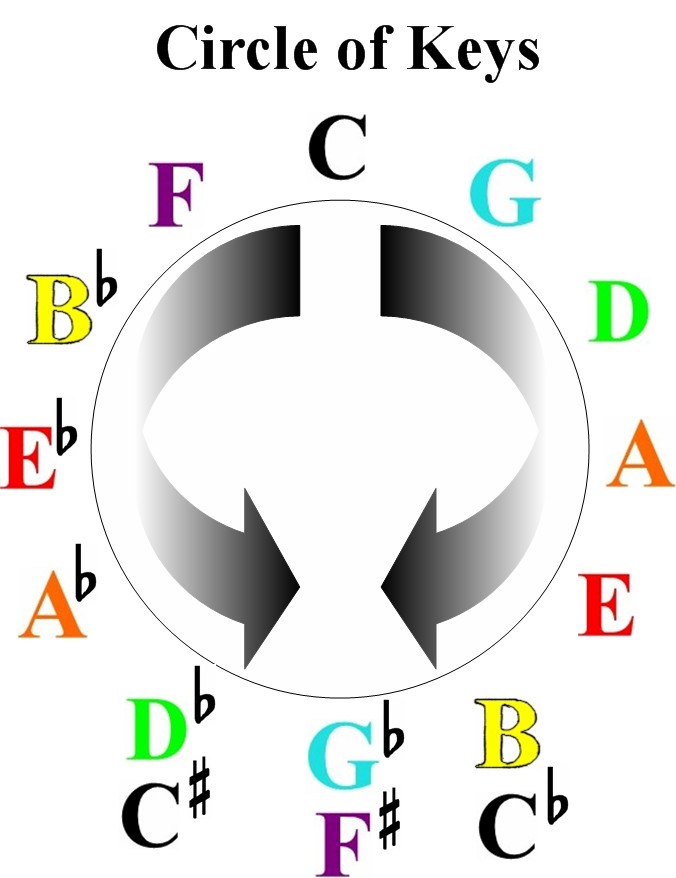 understand the very slight difference between the two. So how is the circle of fifths different than the circle of fourths. They're actually two halfs of the same coin. The circle of fourths is simply the circle of fifths in the opposite direction. In other words, your flats will move clockwise and your sharps will move counter clockwise. Also, instead of each letter in the circle moving up a fifth interval, it will move up a fourth interval. Fourths and fifths are related intervals. If you move up a fourth, it's the same as moving down a fifth. The sharps and flats are exactly the same as well as their overlap at the bottom of the circle.
understand the very slight difference between the two. So how is the circle of fifths different than the circle of fourths. They're actually two halfs of the same coin. The circle of fourths is simply the circle of fifths in the opposite direction. In other words, your flats will move clockwise and your sharps will move counter clockwise. Also, instead of each letter in the circle moving up a fifth interval, it will move up a fourth interval. Fourths and fifths are related intervals. If you move up a fourth, it's the same as moving down a fifth. The sharps and flats are exactly the same as well as their overlap at the bottom of the circle.
The Circle of Keys
The circle of keys refers to both the circle of fifths and the circle of fourths. This is just a way to refer to both perspectives that musicians or instructors may have. But be assured that they're both correct as a tool for the purposes that I've covered in this article.
 Download this free user guide on how to use the circle of fifths and keep it as a handy reference tool when you need it.
Download this free user guide on how to use the circle of fifths and keep it as a handy reference tool when you need it.
It's a free resource and my gift to you for reading this article.
Find out more about Color Score! The easiest way to learn to play the piano like a professional.
Until next time, Go Play!
Greg Lee
Latest posts by Greg Lee (see all)
- What is a minor/Major 7 Chord? - October 26, 2023
- 7 Chord Substitutions that Professionals Use - October 19, 2023
- 5 Simple Chord Tricks to Sound Amazing - October 5, 2023

